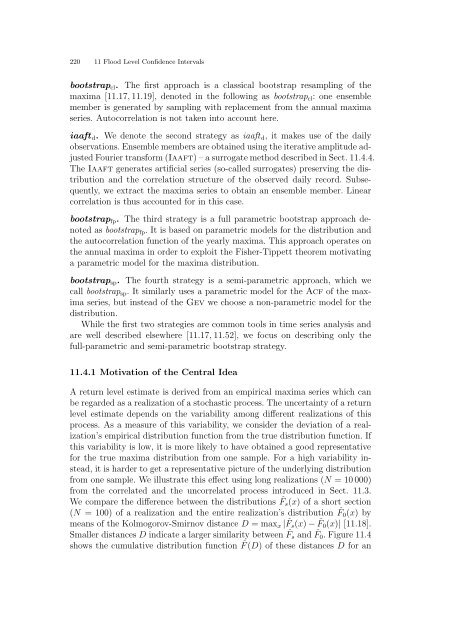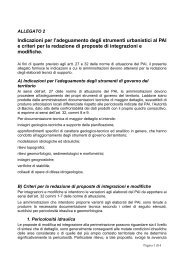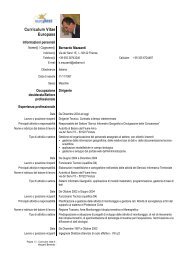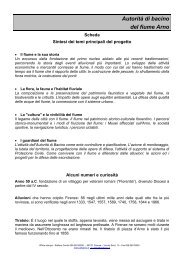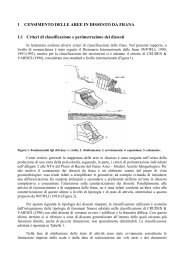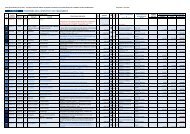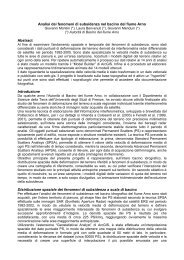11. Confidence Intervals for Flood Return Level Estimates assuming ...
11. Confidence Intervals for Flood Return Level Estimates assuming ...
11. Confidence Intervals for Flood Return Level Estimates assuming ...
You also want an ePaper? Increase the reach of your titles
YUMPU automatically turns print PDFs into web optimized ePapers that Google loves.
220 11 <strong>Flood</strong> <strong>Level</strong> <strong>Confidence</strong> <strong>Intervals</strong>bootstrap cl . The first approach is a classical bootstrap resampling of themaxima [<strong>11.</strong>17, <strong>11.</strong>19], denoted in the following as bootstrap cl : one ensemblemember is generated by sampling with replacement from the annual maximaseries. Autocorrelation is not taken into account here.iaaft d . We denote the second strategy as iaaft d , it makes use of the dailyobservations. Ensemble members are obtained using the iterative amplitude adjustedFourier trans<strong>for</strong>m (Iaaft) – a surrogate method described in Sect. <strong>11.</strong>4.4.The Iaaft generates artificial series (so-called surrogates) preserving the distributionand the correlation structure of the observed daily record. Subsequently,we extract the maxima series to obtain an ensemble member. Linearcorrelation is thus accounted <strong>for</strong> in this case.bootstrap fp . The third strategy is a full parametric bootstrap approach denotedas bootstrap fp . It is based on parametric models <strong>for</strong> the distribution andthe autocorrelation function of the yearly maxima. This approach operates onthe annual maxima in order to exploit the Fisher-Tippett theorem motivatinga parametric model <strong>for</strong> the maxima distribution.bootstrap sp . The fourth strategy is a semi-parametric approach, which wecall bootstrap sp . It similarly uses a parametric model <strong>for</strong> the Acf of the maximaseries, but instead of the Gev we choose a non-parametric model <strong>for</strong> thedistribution.While the first two strategies are common tools in time series analysis andare well described elsewhere [<strong>11.</strong>17, <strong>11.</strong>52], we focus on describing only thefull-parametric and semi-parametric bootstrap strategy.<strong>11.</strong>4.1 Motivation of the Central IdeaA return level estimate is derived from an empirical maxima series which canbe regarded as a realization of a stochastic process. The uncertainty of a returnlevel estimate depends on the variability among different realizations of thisprocess. As a measure of this variability, we consider the deviation of a realization’sempirical distribution function from the true distribution function. Ifthis variability is low, it is more likely to have obtained a good representative<strong>for</strong> the true maxima distribution from one sample. For a high variability instead,it is harder to get a representative picture of the underlying distributionfrom one sample. We illustrate this effect using long realizations (N = 10 000)from the correlated and the uncorrelated process introduced in Sect. <strong>11.</strong>3.We compare the difference between the distributions ˆF s (x) of a short section(N = 100) of a realization and the entire realization’s distribution ˆF 0 (x) bymeans of the Kolmogorov-Smirnov distance D = max x | ˆF s (x) − ˆF 0 (x)| [<strong>11.</strong>18].Smaller distances D indicate a larger similarity between ˆF s and ˆF 0 . Figure <strong>11.</strong>4shows the cumulative distribution function ˆF(D) of these distances D <strong>for</strong> an


